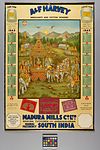Birth of Gita
About this object
History of use
Indian popular religious prints have been published for nearly a century, first by German presses, later by Indian ones. The prints may take the form of calendars, posters, or simply images. The style of the representations is European. In the beginning they were Hindu images, but are now acquiring elements both of folk art and a romantic secularism. It is a living art currently influenced by the movie industry and non-Hindu religions. The images are a vehicle for advertising and are also used for religious purposes.
Cultural context
calendar art; popular religious art
Physical description
Rectangular calendar of a line-drawn coloured illustration depicting the birth of Gita. Scene takes place in large field; central image: ornate gold cart; pyramidal temple on roof forms canopy; four prancing white horses, pulling cart, in profile. Blue skinned male, Krishna, at reins has red u on forehead and three peacock feathers in top of gold crown; looks back at green skinned kneeling male, who is looking at him with his hands placed together in front of body. Bow and arrow filled quiver on ground in front. Horsemen on right; armed foot soldiers (?) on left, each have a red u on forehead. Background has lines of foot soldiers, horse drawn carts and riders on elephants face each other across field. Two winged human figures fly through air; sun low on horizon of grey mountains in distance. Image surrounded by thick yellow border printed with "1943" green calendar along sides; black and blue lettering top and base, "A. &F. Harvey, Merchants and Cotton Spinners, Madura Mills Co. Ltd., South India". Other pink, red and white stamps plus cone and cheese yarn spools in top corners. Metal edged top and base.
Categories
Materials
